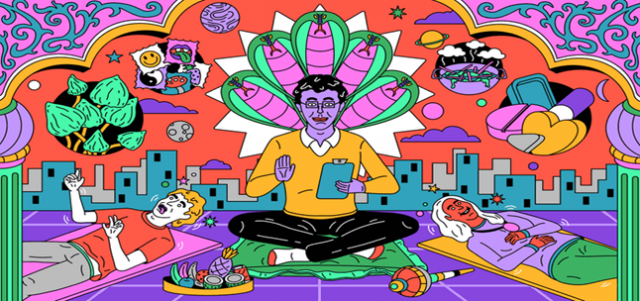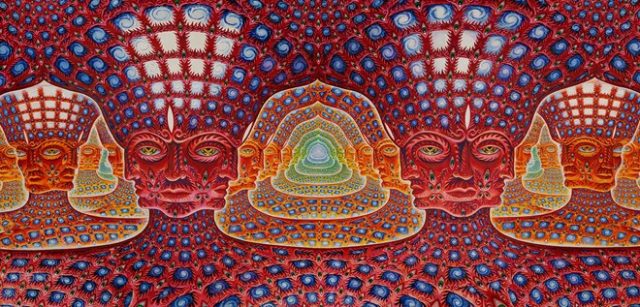In our last blog, we discussed recent findings pertaining to the potential benefits of Psilocybin as an adjunct form of treatment for several psychiatric illness, however, today we’re going to delve back a bit from clinical research to discuss the fundamentals about psychedelics. Today, we’re going to focus on defining what psychedelics(or hallucinogens) are, their origins and most commonly-used forms today – LSD and DMT.
So What Exactly are Psychedelics?
Psychedelics, or serotonergic hallucinogens are a class of drugs that cause profound alterations to our state of consciousness, perception (visual and auditory), mood and cognitive processes, which is attributed to their powerful psychoactive properties.
All psychedelics can be man-made (LSD), or they can be derived from plants (DMT). Typically almost all psychedelics have similar molecular structures to those of endogenous neurotransmitters acetylcholine, serotonin, or catecholamine.
Hallucinogens have been used since ancient times in religion, medicine, magic and prophecy. In the 1960s and 70s, hallucinogen use became a symbol of the counter-culture among young people in North America and Europe. In the 1990s, hallucinogen use was linked to the rave scene.
How Exactly do Psychedelics Work?
Hallucinogens tend to be quite slow in onset, but this varies from drug to drug, and also depends on factors such as whether the drug is taken on an empty stomach.
Psychedelics work similarly to another other class of drug, they work by stimulation, suppressing, or modulating the activity of various neurotransmitters in the brain, the caveat being that the neurotransmitters that they effect are related to their particular structures. They work by inducing a temporary chemical imbalance in the brain.
In other (and more technical terms) serotonergic hallucinogens produce their effects stimulating serotonin 2A receptors, which disrupts coupling between the firing of certain cell types and the rhythmic oscillations of larger populations of neurons. As a result hallucinogens have a disorganising influence on the cognitive processes, thereby allowing the brain to operate in a “freer and less constrained manner.”
LSD A Synopsis
In 1932, Albert Hoffman, a researcher with the Swiss chemical company Sandoz, first developed lysergic acid diethylamide or LSD. LSD was originally synthesized from ergot alkaloids, which was extracted from the ergot fungus, Claviceps Purpurea.. He was working with a chemical found in ergot, a fungus that grows naturally on rye and other grains. It wasn’t until 1943, that Hofmann discovered the drugs hallucinogenic effects after accidentally ingesting a small amount. He reported perceiving extraordinary shapes, with intense kaleidoscopic play of colours. Hofmann is credited a being the father of LSD.

D-Lysergic Acid Diethylamide (LSD) is an odourless, colourless, and is slightly bitter tasting. Today, it is the most potent and notorious of all hallucinogens, and is credited as being the one which brought this family of drugs into the public eye in the 1960’s.
LSD is produced in crystalline form and is then mixed with other inactive ingredients, or diluted as a liquid for production in ingestible forms. LSD comes in various forms, such as:
- Blotter paper (LSD soaked onto sheets of absorbent paper with colorful designs; cut into small, individual dosage units) this is the most common form of LSD
- Thin squares of gelatin (referred to as windowpanes)
- Tablet form (usually small tablets known as Microdots) or capsules
- Liquid on sugar cubes
- Pure liquid form (may be extremely potent)
LSD The Experience

LSD has a slow onset of about an hour but can last anywhere from 4 to 12 hours before it wears off, however, the effect may linger for up to a day or longer, depending on the dosage and potency. The effects commonly experienced while using LSD, are:
- Perceptual distortions – users may experience visual and auditory perceptual changes related to the size and shape of objects, movement, colour, sounds, touch, taste and smell, along with impair depth and time perception.
- Hallucinations
- Flashbacks reliving previous moments in life, or travelling into the future.
- Changes in mood elation, excitement, euphoria.
DMT – A Synopsis
DMT or N, N-dimethyltryptamine in medical talk is a hallucinogenic tryptamine that produces effects similar to those of psychedelics, like LSD and Psilocybin.
The use of DMT can be traced back hundreds of years and is often associated with religious practices or rituals. DMT is used primarily for its psychoactive, hallucinogenic effects. “Spiritual insight” is one of the most commonly reported positive side effects of the drug.
Despite its popularity, DMT has never been as broadly discussed as it counterpart, although it has a long, if not noble history. DMT is one of the most important naturally occurring hallucinogenic compounds, and it is found in many Amazonian plants (Ayahuasca) and in trace amounts in humans where is derived from an essential amino tryptophan during normal metabolism. It has been demonstrated that DMT is unique among classic hallucinogens in that tolerance does not develop to its psychological effects.
DMT was first synthesized in 1921 by Canadian chemist Richard Manske. Its discovery as the active ingredient in Cohoba, resulted in further examination of its psychoactive properties in 1956.

DMT comes as a white, crystalline powder that can be vaporized or smoked. DMT can be consumed using various routes of administration, most commonly:
- Smoked – Fastest route of administration, producing effects within 10 minutes.
- Vaporized
- Injected
- Snorted
- Tea – Slowest rout of administration, producing effects within 45 minutes. This method is often used in spiritual ceremonies.
DMT – The Experience

DMT has a relatively fast-acting psychedelic, in that its onset can ranges between 5 to 60 minutes, depending on the route of administration, dosage, potency and whether you have eaten. The effects can last up to 30 to 45 minutes (when smoked) and up to 4 to 5 hours when ingested (tea), however, it has been reported that the effects can potentially linger up to 24 hours or more in specific instances. Additionally, DMT is consider to have the lowest side effect profile, relative to other hallucinogens.
The effects commonly experienced while using DMT, are:
- Euphoria
- Floating sensation
- Visual and auditory hallucinations
- Depersonalization/disassociation
- Heightened sensation (touch)
- Epiphany or life changing experiences


